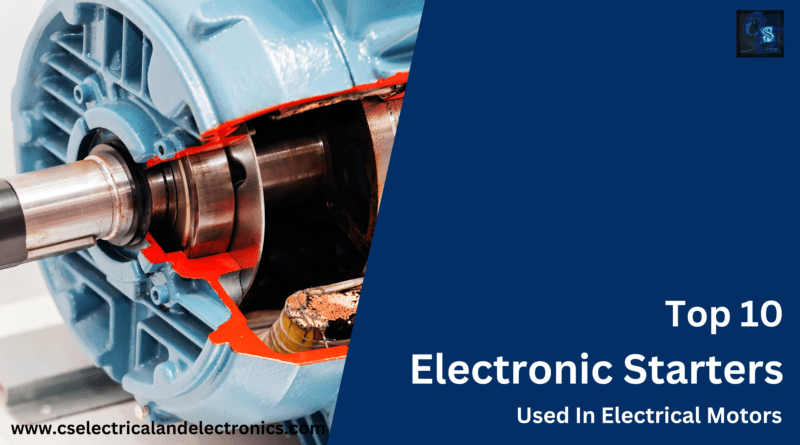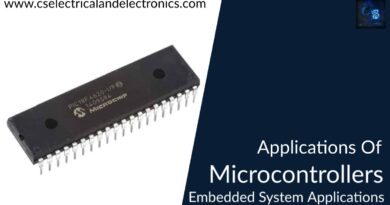Top 10 Electronic Starters Used In Electrical Motors, Latest Starters
Hello guys, welcome back to our blog. Here in this article, we will discuss the top 10 electronic starters used in electrical motors, the working of electronic starters, and which starter is used in electrical motors.
If you have any electrical, electronics, and computer science doubts, then ask questions. You can also catch us on Instagram – CS Electrical & Electronics.
Also, read:
- Top 20 Algorithms Electrical And Electronics Engineers Must Know
- What Is ECU In Vehicles, Electronic Control Unit, Purpose, Types
- Top 20 Real-Time Power System Monitoring Software
Top 10 Electronic Starters Used In Electrical Motors
Electrical motor starters are used to regulate the voltage and starting current provided to the motor during the starting phase. When an electrical motor is turned on, a large amount of current is drawn from the power source, which can result in voltage drops and have an impact on other devices connected to the same power source. The motor may experience mechanical stress as a result of the high starting current, which could result in damage or shorter motor life.
The mechanical stress on the motor can be reduced and voltage dips in the power supply can be avoided by utilizing a starter, which allows the starting current and voltage to be controlled and gradually increased.
Other safety measures that starters offer include overload protection and automated shut-off in the event of a malfunction or unexpected operating circumstance.
In order to ensure the safe and effective running of the motor and the related equipment, starters are a crucial part of electrical motor control systems.
Top 10 Electronic Starters
10. Direct-On-Line (DOL) Starter:
An electronic starter used with electrical motors is called a Direct-On-Line (DOL) starter. It is used for motors with modest starting currents and is the simplest and most popular form of starter.
A switch or contactor is used to start and stop the motor when using a DOL starter, which has the motor linked directly to the power source. The motor starts and runs at full speed when the switch or contactor is closed, supplying it with full voltage.
A DOL starter has the advantages of being easy to use and inexpensive. It takes little upkeep and is simple to install. The abrupt high starting current can induce voltage dips in the power supply and mechanical stress on the motor, making it unsuitable for motors with high starting currents.
DOL starters are frequently employed in situations where a sudden high starting current is not a concern, such as pumps, fans, and conveyors. Moreover, they are utilized in small motors since more sophisticated starters would be prohibitively expensive.
09. Star-Delta Starter:
Electronic starters of the Star-Delta variety are employed with electric motors that require large starting currents. It is made to lessen the mechanical strain on the motor during the starting phase and the starting current.
A Star-Delta Starter restricts the amount of current that can pass through the motor windings by initially connecting the motor in a star configuration. The starter changes to a delta design once the motor has achieved a particular speed, enabling the motor to operate at full speed. A unique sort of contactor called a star-delta contactor is used to convert from star to delta configuration.
A Star-Delta Starter has the advantage of lowering the high starting current and mechanical stress on the motor during the starting phase, which can increase the motor’s lifespan and prevent voltage dips in the power supply. Nevertheless, it necessitates extra parts, including a timer and star-delta contactor, which can raise the price and complexity of the motor control system.
When strong starting currents are needed, Star-Delta Starters are frequently employed in equipment including air compressors, centrifugal pumps, and conveyor belts. While the reduced starting current can save motor wear and tear and increase energy economy, they are also employed in situations where the motor is started frequently.
08. Auto Transformer Starter:
An electronic starter known as an autotransformer starter is used with electric motors that require moderate to high starting currents. It is made to lessen the voltage and starting current that is applied to the motor when it is starting.
An autotransformer is used in an autotransformer starter to lower the starting voltage applied to the motor. The voltage applied to the motor is decreased because the autotransformer is first connected to the motor windings in a series configuration. The autotransformer is switched to a parallel configuration after the motor reaches a particular speed, enabling the motor to operate at full speed.
An Auto Transformer Starter has the advantage of reducing the high starting current and voltage applied to the motor during the starting phase, which can increase the motor’s lifespan and avoid voltage dips in the power supply. Also, because it uses fewer parts than a Star-Delta Starter, the motor control system may be less expensive and complex.
In applications requiring moderate to high starting currents, such as water pumps, blowers, and compressors, auto transformer starters are frequently employed. Although the reduced starting current and voltage can save motor wear and tear and enhance energy economy, they are also employed in situations where the motor is started frequently.
07. Soft Starter:
An electronic starter known as a soft starter is used with electric motors that require large starting currents. This decreases the starting current and mechanical stress on the motor by gradually raising the voltage and frequency delivered to it during the starting phase.
A sequence of solid-state components, like thyristors or transistors, are used in a soft starter to regulate the voltage and frequency applied to the motor. In order to limit the beginning current and voltage spikes applied to the motor, the solid-state components are progressively turned on and off. The solid-state electronics are fully turned on and the motor runs at full speed after it has reached a particular speed.
A soft starter’s benefit is that it lessens the mechanical stress placed on the motor during the starting process, extending the motor’s lifespan and preventing voltage drops in the power supply. Additionally, it offers fine control over the motor’s starting current and speed, which helps raise the motor’s effectiveness and performance.
Applications requiring large starting currents, such as pumps, fans, and conveyors, frequently use soft starters. While the reduced starting current can save motor wear and tear and increase energy economy, they are also employed in situations where the motor is started frequently. They are more expensive than other starting varieties, though, and their installation and upkeep are more involved.
06. Variable Frequency Drive (VFD):
A form of electronic starter used for electrical motors is a variable frequency drive (VFD), commonly referred to as an adjustable frequency drive. It is intended to give precise control over the motor’s speed and torque by altering the power supply’s frequency and voltage.
In a VFD, the AC power source is transformed from AC to DC using a rectifier, and then back to AC using an inverter at a variable frequency and voltage. The control circuitry of the VFD can be used to modify the frequency and voltage of the output power, providing fine control over the motor’s speed and torque.
The benefit of a VFD is that it offers exact control over the motor’s speed and torque, which can raise the motor’s performance and efficiency. By gradually raising the voltage and frequency during the starting phase, also lessens the mechanical stress on the motor, potentially extending its lifespan.
VFDs are frequently employed in situations where precise control over the speed and torque of the motor is necessary, such as with pumps, fans, and conveyors. They can reduce energy consumption by altering the motor speed to meet the load, therefore they are utilized in applications where energy economy is a priority. They are more expensive than other starting varieties, though, and their installation and upkeep are more involved.
05. Electronic Starter with a Timer:
For electrical motors that demand a particular starting sequence, an electronic starter with a timer is a form of electronic starter. It is intended to use a programmable timer to regulate the motor’s starting and stopping.
A number of solid-state components, including thyristors or transistors, are employed in an electronic starter with a timer to regulate the voltage and frequency applied to the motor. A programmable timer that can be set to start and stop the motor at predetermined intervals or times controls the solid-state devices. In cases where the motor needs to be started slowly to reduce mechanical stress, the timer can also be used to regulate the length of the starting process.
An electronic starter with a timer has the benefit of giving exact control over the motor’s starting process, which can increase the motor’s effectiveness and performance. By ensuring that it is started and stopped in precise order or at specific times, it can also be utilized to prevent damage to the motor.
Conveyor systems, packaging equipment, and printing presses are a few examples of applications that frequently use electronic starters with timers to precisely manage the motor’s starting process. They can also be utilized in situations where the motor must be started slowly to lessen mechanical stress or where the motor must be constantly started and stopped. They are more expensive than other starting varieties, though, and their installation and upkeep are more involved.
04. Reduced Voltage Starter:
An electronic starter known as a “reduced voltage starter” is used with electrical motors that have lower starting torque and current requirements. By progressively delivering voltage to the motor, it is intended to lessen the mechanical stress on the motor during the starting phase.
A reduced voltage starter reduces the motor’s starting current and torque by gradually and incrementally raising the voltage delivered to the motor. As a result, the motor experiences less mechanical stress upon starting, which contributes to a longer motor lifespan. There are several ways to use the reduced voltage starter, including wye-delta, autotransformer, and solid-state soft start.
A reduced voltage starter has the advantage of lowering the motor’s high starting current and torque, which can lessen mechanical stress and minimize voltage dips in the power supply. Additionally, it offers fine control over the motor’s starting current and torque, which can raise the motor’s effectiveness and performance.
Lower Voltage Starters are frequently employed in situations where strong starting currents and torque are necessary, such as with compressors, conveyors, and huge motors. While the reduced starting current can save motor wear and tear and increase energy economy, they are also employed in situations where the motor is started frequently. They are more expensive than other starting varieties, though, and their installation and upkeep are more involved.
03. Solid State Starter:
An electronic starting known as a solid-state starter is used with electric motors that need to have precise control over their speed and torque. It is intended to use silicon-controlled rectifiers, thyristors, or other solid-state devices to provide fine control over the motor’s power source (SCRs).
With a solid-state starter, the solid-state components are utilized to regulate the voltage and frequency of the motor’s power supply, giving the motor’s speed and torque exact control. A microprocessor or programmable logic controller (PLC), which may be configured to provide particular control settings for the motor, is used to operate the solid-state devices.
The benefit of a solid-state starter is that it offers exact control over the motor’s speed and torque, which can raise the motor’s performance and efficiency. By gradually raising the voltage and frequency during the starting phase, it can also lessen the mechanical stress on the motor, extending its lifespan.
When precise control over the speed and torque of the motor is necessary, applications like pumps, fans, compressors, and conveyors frequently use solid-state starters. They can reduce energy consumption by altering the motor speed to meet the load, therefore they are utilized in applications where energy economy is a priority. They are more expensive than other starting varieties, though, and their installation and upkeep are more involved.
02. Wye-Delta Starter:
For three-phase AC induction motors, a Wye-Delta Starter is a particular kind of electronic starter. It is made with the intention of lowering the motor’s beginning current and torque, which can lessen mechanical strain and prevent voltage drops in the power supply.
The motor is initially linked to a wye (or star) configuration in a Wye-Delta Starter, which reduces the voltage provided to each winding by a factor of three. This lowers the motor’s beginning current and torque, which lessens the mechanical strain the motor experiences while starting. The motor is then connected to a delta configuration after a predetermined amount of time, which applies the entire voltage to each winding and gives the motor its maximum torque.
A Wye-Delta Starter has the advantage of lowering the motor’s high starting current and torque, which helps lessen mechanical stress and avoid voltage dips in the power supply. It also offers a quick and trustworthy way to lessen the motor’s starting current and torque.
Wye-Delta Starters are frequently employed in situations where high starting currents and torque are necessary, such as with big motors, pumps, and fans. While the reduced starting current can save motor wear and tear and increase energy economy, they are also employed in situations where the motor is started frequently. Although they can offer more exact control over the motor’s starting current and torque, they are less effective than other starter types including soft starts and variable frequency drives.
01. Autotransformer Star-Delta Starter:
For three-phase AC induction motors, an Autotransformer Star-Delta Starter is a type of electronic starter. It is made with the intention of lowering the motor’s beginning current and torque, which can lessen mechanical strain and prevent voltage drops in the power supply.
The motor is initially connected to an autotransformer in a star configuration in an autotransformer star-delta starter, which lowers the voltage provided to each winding by a specific percentage. This lowers the motor’s beginning current and torque, which lessens the mechanical strain the motor experiences while starting. The motor is then connected to a delta configuration after a predetermined amount of time, which applies the entire voltage to each winding and gives the motor its maximum torque.
An Autotransformer Star-Delta Starter has the advantage of lowering the motor’s high starting current and torque, which can lessen mechanical stress and minimize voltage dips in the power supply. It also offers a quick and trustworthy way to lessen the motor’s starting current and torque.
Large motors, pumps, and fans are just a few examples of situations where autotransformer Star-Delta Starters are frequently employed. While the reduced starting current can save motor wear and tear and increase energy economy, they are also employed in situations where the motor is started frequently. Although they can offer more exact control over the motor’s starting current and torque, they are less effective than other starter types including soft starts and variable frequency drives.
This was about “Top 10 Electronic Starters Used In Electrical Motors“. I hope this article may help you all a lot. Thanks for reading.
Also, read:
- 10 Tips To Maintain Battery For Long Life, Battery Maintainance
- 10 Tips To Save Electricity Bills, Save Money By Saving Electricity
- 100 (AI) Artificial Intelligence Applications In The Automotive Industry
- 100 + Electrical Engineering Projects For Students, Engineers
- 1000+ Control System Quiz, Top MCQ On Control System
- 1000+ Electrical Machines Quiz, Top MCQs On Electrical Machines
- 1000+ MATLAB Simulink Projects For MTech, Engineering Students
- 50 Tips To Save Electricity At Home, Shop, Industry, Office
Author Profile
- Chetu
- Interest's ~ Engineering | Entrepreneurship | Politics | History | Travelling | Content Writing | Technology | Cooking
Latest entries
 All PostsApril 13, 2024What Is TCM, Transmission Control Module, Working, Purpose,
All PostsApril 13, 2024What Is TCM, Transmission Control Module, Working, Purpose, All PostsApril 12, 2024Top 100 HiL hardware in loop Interview Questions With Answers For Engineers
All PostsApril 12, 2024Top 100 HiL hardware in loop Interview Questions With Answers For Engineers All PostsMarch 22, 2024Driver Monitoring Systems In Vehicles, Working, Driver Sleepy Alert
All PostsMarch 22, 2024Driver Monitoring Systems In Vehicles, Working, Driver Sleepy Alert All PostsMarch 10, 2024Top 100 Automotive Interview Questions With Answers For Engineers
All PostsMarch 10, 2024Top 100 Automotive Interview Questions With Answers For Engineers








